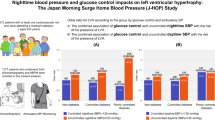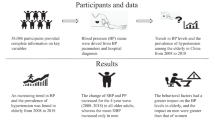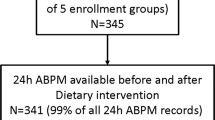Abstract
Studies have reported that short-term blood pressure (BP) variability (BPV) is associated with type 2 diabetes mellitus (T2DM) incidence, but the association with long-term BPV remains unclear. The present study investigated the associations of long-term BPV as well as the time trend of BP changes over time with the incidence of T2DM. This study followed a cohort of 3017 Japanese individuals (2446 male, 571 female) aged 36–65 years from 2007 through March 31, 2019. The root-mean-square error (RMSE) and the slope of systolic BP (SBP) change regressed on year were calculated individually using SBP values obtained from 2003 to baseline (2007). A multivariable Cox proportional hazard model was applied to estimate hazard ratios (HRs) and corresponding 95% confidence intervals (CIs) for tertiles of SBP RMSE and continuous SBP slopes adjusted for age, sex, smoking status, regular exercise, sodium intake, family history of diabetes, sleep disorder, body mass index (BMI), SBP, and fasting blood glucose (FBG) at baseline, and BMI slope from 2003 to 2007. The highest RMSE tertile compared to the lowest was associated with a significantly higher incidence of T2DM after adjusting for covariates (HR: 1.79, 95% CI: 1.15, 2.78). The slope was also significantly associated with T2DM incidence until baseline SBP and FBG were adjusted (HR: 1.03, 95% CI: 0.99, 1.07). In conclusion, long-term SBP variability was significantly associated with an increased incidence of T2DM independent of baseline age, sex, BMI, SBP, FBG, lifestyle factors and BMI slope from 2003 until baseline.
This is a preview of subscription content, access via your institution
Access options
Subscribe to this journal
Receive 12 print issues and online access
$259.00 per year
only $21.58 per issue
Buy this article
- Purchase on Springer Link
- Instant access to full article PDF
Prices may be subject to local taxes which are calculated during checkout

Similar content being viewed by others
References
Yuzyuk T, Lozier B, Schwarz EL, Viau K, Kish-Trier E, De Biase I. Intra-individual variability of long-chain fatty acids (C12-C24) in plasma and red blood cells. Prostaglandins Leukot Essent Fat Acids. 2018;135:30–8.
Zhu B, Kapella MC, Zhao X, Fritschi C. Intra-individual variability in sleep is related to glycaemic control in adults with type 2 diabetes. J Adv Nurs. 2020;76:991–8.
Gosmanova EO, Mikkelsen MK, Molnar MZ, Lu JL, Yessayan LT, Kalantar-Zadeh K, et al. Association of systolic blood pressure variability with mortality, coronary heart disease, stroke, and renal disease. J Am Coll Cardiol. 2016;68:1375–86.
Muntner P, Shimbo D, Tonelli M, Reynolds K, Arnett DK, Oparil S. The relationship between visit-to-visit variability in systolic blood pressure and all-cause mortality in the general population: findings from NHANES III, 1988 to 1994. Hypertension. 2011;57:160–6.
Nardin C, Rattazzi M, Pauletto P. Blood pressure variability and therapeutic implications in hypertension and cardiovascular diseases. High Blood Press Cardiovasc Prev. 2019;26:353–9.
Nagai M, Kario K. Visit-to-visit blood pressure variability, silent cerebral injury, and risk of stroke. Am J Hypertens. 2013;26:1369–76.
Stevens SL, Wood S, Koshiaris C, Law K, Glasziou P, Stevens RJ, et al. Blood pressure variability and cardiovascular disease: systematic review and meta-analysis. BMJ. 2016;354:i4098.
Chiriacò M, Pateras K, Virdis A, Charakida M, Kyriakopoulou D, Nannipieri M, et al. Association between blood pressure variability, cardiovascular disease and mortality in type 2 diabetes: a systematic review and meta-analysis. Diabetes Obes Metab. 2019;21:2587–98.
Vidal-Petiot E, Stebbins A, Chiswell K, Ardissino D, Aylward PE, Cannon CP, et al. Visit-to-visit variability of blood pressure and cardiovascular outcomes in patients with stable coronary heart disease. Insights from the STABILITY trial. Eur Heart J. 2017;38:2813–22.
Zhou TL, Kroon AA, Reesink KD, Schram MT, Koster A, Schaper NC, et al. Blood pressure variability in individuals with and without (pre)diabetes: the Maastricht study. J Hypertens. 2018;36:259–67.
Okada R, Yasuda Y, Tsushita K, Wakai K, Hamajima N, Matsuo S. Within-visit blood pressure variability is associated with prediabetes and diabetes. Sci Rep. 2015;5:7964.
Joshipura KJ, Muñoz-Torres FJ, Campos M, Rivera-Díaz AD, Zevallos JC. Association between within-visit systolic blood pressure variability and development of pre-diabetes and diabetes among overweight/obese individuals. J Hum Hypertens. 2017;32:26–33.
Emdin CA, Anderson SG, Woodward M, Rahimi K. Usual blood pressure and risk of new-onset diabetes: evidence from 4.1 million adults and a meta-analysis of prospective studies. J Am Coll Cardiol. 2015;66:1552–62.
Yano Y, Fujimoto S, Kramer H, Sato Y, Konta T, Iseki K, et al. Long-term blood pressure variability, new-onset diabetes mellitus, and new-onset chronic kidney disease in the Japanese general population. Hypertension. 2015;66:30–6.
Lissner L, Andres R, Muller DC, Shimokata H. Body weight variability in men: metabolic rate, health and longevity. Int J Obes. 1990;14:373–83.
Cheng Y, Li J, Ren X, Wang D, Yang Y, Miao Y, et al. Visit-to-visit office blood pressure variability combined with Framingham risk score to predict all-cause mortality: a post hoc analysis of the systolic blood pressure intervention trial. J Clin Hypertens. 2021;23:1516–25.
Yano Y. Visit-to-visit blood pressure variability—what is the current challenge? Am J Hypertens. 2017;30:112–4.
Zhang Y, Yatsuya H, Li Y, Chiang C, Hirakawa Y, Kawazoe N, et al. Long-term weight-change slope, weight fluctuation and risk of type 2 diabetes mellitus in middle-aged Japanese men and women: findings of Aichi Workers’ Cohort Study. Nutr Diabetes. 2017;7:e252.
Nathan DM, Davidson MB, DeFronzo RA, Heine RJ, Henry RR, Pratley R, et al. Impaired fasting glucose and impaired glucose tolerance: implications for care. Diabetes Care. 2007;30:753–9.
Wada K, Yatsuya H, Ouyang P, Otsuka R, Mitsuhashi H, Takefuji S, et al. Self-reported medical history was generally accurate among Japanese workplace population. J Clin Epidemiol. 2009;62:306–13.
Linderman GC, Lu J, Lu Y, Sun X, Xu W, Nasir K, et al. Association of body mass index with blood pressure among 1.7 million Chinese adults. JAMA Netw Open. 2018;1:e181271.
Mancia G, Parati G, Pomidossi G, Casadei R, Di Rienzo M, Zanchetti A. Arterial baroreflexes and blood pressure and heart rate variabilities in humans. Hypertension. 1986;8:147–53.
Parati G, Castiglioni P, Di Rienzo M, Omboni S, Pedotti A, Mancia G. Sequential spectral analysis of 24-hour blood pressure and pulse interval in humans. Hypertension. 1990;16:414–21.
Parati G, Saul JP, Di Rienzo M, Mancia G. Spectral analysis of blood pressure and heart rate variability in evaluating cardiovascular regulation. A critical appraisal. Hypertension. 1995;25:1276–86.
Conway J, Boon N, Davies C, Jones JV, Sleight P. Neural and humoral mechanisms involved in blood pressure variability. J Hypertens. 1984;2:203–8.
Ozawa M, Tamura K, Iwatsubo K, Matsushita K, Sakai M, Tsurumi-Ikeya Y, et al. Ambulatory blood pressure variability is increased in diabetic hypertensives. Clin Exp Hypertens. 2008;30:213–24.
Ruiz J, Monbaron D, Parati G, Perret S, Haesler E, Danzeisen C, et al. Diabetic neuropathy is a more important determinant of baroreflex sensitivity than carotid elasticity in type 2 diabetes. Hypertension. 2005;46:162–7.
Frattola A, Parati G, Gamba P, Paleari F, Mauri G, Di Rienzo M, et al. Time and frequency domain estimates of spontaneous baroreflex sensitivity provide early detection of autonomic dysfunction in diabetes mellitus. Diabetologia. 1997;40:1470–5.
Salles GF, Reboldi G, Fagard RH, Cardoso CR, Pierdomenico SD, Verdecchia P, et al. Prognostic effect of the nocturnal blood pressure fall in hypertensive patients: the Ambulatory Blood Pressure Collaboration in Patients With Hypertension (ABC-H) meta-analysis. Hypertension. 2016;67:693–700.
Nagai M, Hoshide S, Ishikawa J, Shimada K, Kario K. Visit-to-visit blood pressure variations: new independent determinants for carotid artery measures in the elderly at high risk of cardiovascular disease. J Am Soc Hypertens. 2011;5:184–92.
Flaa A, Aksnes TA, Kjeldsen SE, Eide I, Rostrup M. Increased sympathetic reactivity may predict insulin resistance: an 18-year follow-up study. Metabolism. 2008;57:1422–7.
Thorp AA, Schlaich MP. Relevance of sympathetic nervous system activation in obesity and metabolic syndrome. J Diabetes Res. 2015;2015:341583.
Kiba T. Relationships between the autonomic nervous system and the pancreas including regulation of regeneration and apoptosis: recent developments. Pancreas. 2004;29:e51–8.
Ortiz-Alonso FJ, Herman WH, Zobel DL, Perry TJ, Smith MJ, Halter JB. Effect of epinephrine on pancreatic beta-cell and alpha-cell function in patients with NIDDM. Diabetes. 1991;40:1194–202.
Liu YP, Gu YM, Thijs L, Asayama K, Jin Y, Jacobs L, et al. Do level and variability of systolic blood pressure predict arterial properties or vice versa? J Hum Hypertens. 2014;28:316–22.
Diaz KM, Veerabhadrappa P, Kashem MA, Thakkar SR, Feairheller DL, Sturgeon KM, et al. Visit-to-visit and 24-h blood pressure variability: association with endothelial and smooth muscle function in African Americans. J Hum Hypertens. 2013;27:671–7.
National High Blood Pressure Education Program. The seventh report of the Joint National Committee on prevention, detection, evaluation, and treatment of high blood pressure. Bethesda (MD): National Heart, Lung, and Blood Institute (US); 2004.
Ushigome E, Kitagawa N, Kitae A, Kimura T, Iwai K, Oyabu C, et al. Seasonal variation in home blood pressure and its relationship with room temperature in patients with type 2 diabetes. Diab Vasc Dis Res. 2020;17:1479164119883986.
Bliziotis IA, Destounis A, Stergiou GS. Home versus ambulatory and office blood pressure in predicting target organ damage in hypertension: a systematic review and meta-analysis. J Hypertens. 2012;30:1289–99.
Abellán-Huerta J, Prieto-Valiente L, Montoro-García S, Abellán-Alemán J, Soria-Arcos F. Correlation of blood pressure variability as measured by clinic, self-measurement at home, and ambulatory blood pressure monitoring. Am J Hypertens. 2018;31:305–12.
Acknowledgements
The authors would like to thank the participants and health care personnel of the local government office, the technical assistance of Mr. Hidetoshi Ichimura, and Professor Emeritus Hideaki Toyoshima who founded the Aichi Workers' Cohort Study. The author (ZS) also thanks the “Nagoya University Interdisciplinary Frontier Fellowship” sponsored by Japan Science and Technology (JST) and Nagoya University for the support.
Funding
This work was supported in part by MEXT/JSPS KAKENHI (grant numbers 09470112, 13470087 and 17390185 to Hideaki Toyoshima; 13770192, 15689011, 17790384, 20790438, 22390133, 23659346, 26293153 18H03057 and 22H03349 to HY; 12670352, 16590499, 18590594, 20590641, 23590787, 15K08802 and 20K10496 to KT; 25893088, 16K19278 and 19K19419 to YL); Health and Labor Sciences research grants for Comprehensive Research on Cardiovascular and Life-Style Related Diseases (H26-Junkankitou [Seisaku]-Ippan-001, H29-Junkankitou [Seishuu]-Ippan-003, and 20FA1002) from the Ministry of Health, Labor and Welfare; and research grants from the Japan Atherosclerosis Prevention Fund, the Aichi Health Promotion Foundation, the Uehara Memorial Fund, and fund from the Noguchi Memorial Research Institute.
Author information
Authors and Affiliations
Corresponding author
Ethics declarations
Conflict of interest
The authors declare no competing interests.
Additional information
Publisher’s note Springer Nature remains neutral with regard to jurisdictional claims in published maps and institutional affiliations.
Supplementary information
Rights and permissions
Springer Nature or its licensor holds exclusive rights to this article under a publishing agreement with the author(s) or other rightsholder(s); author self-archiving of the accepted manuscript version of this article is solely governed by the terms of such publishing agreement and applicable law.
About this article
Cite this article
Song, Z., He, Y., Chiang, C. et al. Long-term variability and change trend of systolic blood pressure and risk of type 2 diabetes mellitus in middle-aged Japanese individuals: findings of the Aichi Workers’ Cohort Study. Hypertens Res 45, 1772–1780 (2022). https://doi.org/10.1038/s41440-022-00993-2
Received:
Revised:
Accepted:
Published:
Issue Date:
DOI: https://doi.org/10.1038/s41440-022-00993-2
Keywords
This article is cited by
-
2023 update and perspectives
Hypertension Research (2024)
-
Pathogenic connection between hypertension and type 2 diabetes: how do they mutually affect each other?
Hypertension Research (2022)



